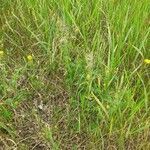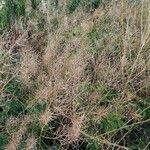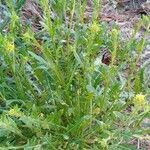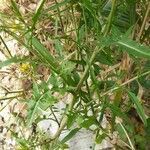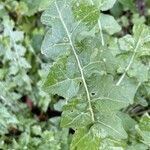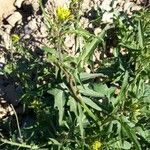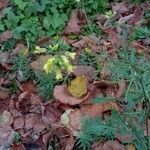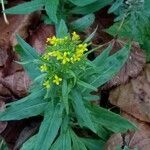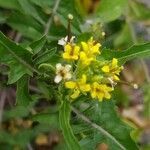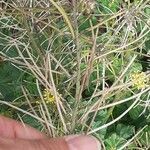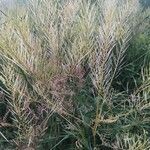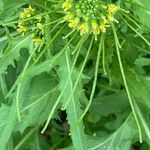Annuals; glabrous or sparsely pubescent. Stems erect, branched proximally and distally, (1-)2-6(-7.5) dm, glabrous or sparsely pubescent at least basally. Basal leaves not rosulate; petiole (0.5-)1-4.5(-6) cm; blade oblanceolate or oblong (in outline), (1.5-)3-12 (-15) cm × (5-)10-60(-90) mm, margins runcinate to pinnatisect; lobes (1-)2-6(-8) on each side, oblong or lanceolate, smaller than terminal lobe, margins entire, dentate, or lobed. Cauline leaves similar to basal; (distalmost) blade (smaller, to 2 cm wide), margins entire or 1-3-lobed. Fruiting pedicels divaricate or ascending, slender, much narrower than fruit, (5-)7-12(-20) mm. Flowers: sepals erect, oblong, 2-2.5 × 1-1.5 mm; petals oblong-oblanceolate, 2.5-3.5(-4) × 1-1.5 mm, claw 1-1.5 mm; filaments 2.5-4 mm; anthers ovate, 0.5-0.9 mm. Fruits (divaricate to ascending, young fruits overtopping flowers), narrowly linear, straight or slightly curved inward, slightly torulose, slender, (2.5-)3-4(-5) cm × 0.9-1.1 mm; valves glabrous; ovules 40-90 per ovary; style 0.2-0.5 mm; stigma prominently 2-lobed. Seeds 0.8-1 × 0.5-0.6 mm. 2n = 14.
Annual herbs 10-60 cm tall; glabrous or with short, appressed hairs, especially on young growth. Lower leaves runcinate-pinnatifid with 2-6 pairs of lateral lobes; lobes mostly toothed or somewhat lobed. Stem leaves upwards with gradually fewer, smaller, lateral lobes and a more prominent terminal lobe; upper leaves petiolate, simply hastate or with a few small, narrow, lateral lobes. Inflorescence ebracteate, very dense and contracted in flower; in fruit elongate, with the young fruits overtopping the flowers and buds. Flowers inconspicuous, the petals pale yellow, 2.5-3 mm long, hardly exceeding the sepals. Anthers 0.5-0.8 mm long. Siliquae 3-5 cm long, c. 1 mm in diameter, linear, straight or curved, ascending on slender pedicels 6-10 mm long; valves 3-nerved, glabrous, bulged by the seeds; stigma subsessile, 2-lobed. Seeds numerous (60-80), in 1 row, yellowish, less than 1 mm long.
Annual or biennial herb 25–60 cm high, erect, glabrous or with long, curved hairs. Lower leaves not in a rosette, deeply sinuate-pinnatifid with 2–6 pairs of lobes, petiolate, dentate; upper leaves reducing, sometimes entire. Sepals erect, 3.5–3.0 mm long, glabrous. Petals 2.5–3.5 rarely 6 mm long, pale yellow. Style narrow, 0.5 mm long. Siliqua 25–65 mm long, 0.5–1 mm wide, torulose, curved; valves glabrous, thin-walled, almost translucent; pedicels slender, spreading, 6–10 mm long. Seeds ovoid, 1–1.5 mm long.
Erect, to 6 dm, spreading-hairy below; lower lvs deeply pinnatifid with oblong to ovate, entire to dentate or angularly lobed segments, the upper lvs with fewer and smaller lobes; infl very contracted, the young frs elongating rapidly and projecting beyond the fls; sep 2–3 mm; pet 3–4 mm; anthers ca 0.7 mm; pedicels slender, divergent, 5–10 mm; frs linear, 2.5–5 cm; 2n=14, 28, 42, 56. Native of Eurasia, occasionally found in our range, and becoming a weed in the Pacific states. May, June. (Norta i.)
A cabbage family herb. It is an annual plant. It grows up to 70 cm tall. It is almost hairless. The leaves are oblong to sword shaped. The flowers are pale yellow. The seed pod stalk is slender. The fruit are narrow and 3-4 cm long by 1 mm wide. The seeds are oblong and 1 mm long by 0.5 mm wide.
